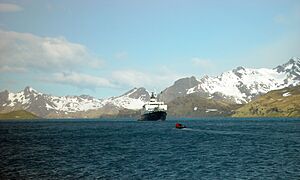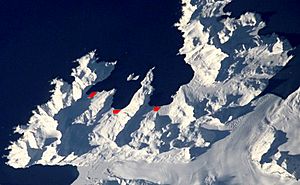Stromness Bay facts for kids
Stromness Bay is a large bay on the north coast of South Georgia. It is about 3 miles (4.8 kilometers) wide. The bay is located between two points of land called Cape Saunders and Busen Point.
Stromness Bay is named after a town in Scotland called Stromness. Both places were important centers for whaling, which is why they share the same name. Busen Point is a headland that forms the southeast side of the bay's entrance. Close to Busen Point is a rock called Bucentaur Rock.
Contents
History of Stromness Bay
Stromness Bay was likely first seen in 1775 by Captain James Cook. It was given its name around 1912. This name was probably chosen by Norwegian whalers who often visited its harbors.
Shackleton's Famous Journey
Stromness Bay is very important in history because of Ernest Shackleton. In 1916, he made an amazing rescue journey across South Georgia. His goal was to reach Stromness Bay to get help for his stranded crew. This journey is one of the most famous survival stories ever.
World War II and South Georgia
During the Second World War, most whaling stations on South Georgia had to close. Only Grytviken and Leith Harbour stayed open. Many whaling ships were destroyed by German forces. Other ships were used by the Allied forces to help with the war.
British officials on the island worked to protect it during the war. The Royal Navy used a ship called the Queen of Bermuda to patrol the waters around South Georgia. They also placed large guns at Cumberland Bay and Stromness Bay. These guns were meant to protect Grytviken and Leith Harbour. Norwegian whalers volunteered to operate these guns, which are still there today.
Whaling Stations in the Bay
Stromness Bay was home to three important whaling stations: Husvik, Stromness, and Leith Harbour. These stations were connected by a rough path along the beach. Whalers from Husvik and Stromness would often walk to Leith Harbour. This was because Leith Harbour had the only cinema on the island.
See also
 In Spanish: Bahía Stromness para niños
In Spanish: Bahía Stromness para niños



